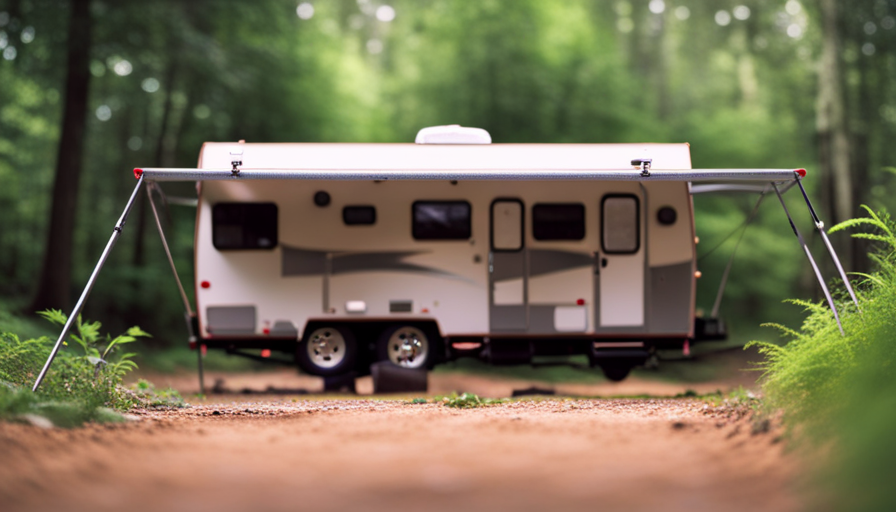Picture yourself towing a trailer on the open road, feeling just as steady and safe as a boat gliding smoothly across calm waters. Achieving this serene experience is completely possible with the right equipment. Want to learn more and discover why this experience is worth it?
Sway bars, also known as stabilizer bars, are a crucial component in ensuring a smooth and safe towing experience for campers. They act like a pair of skilled hands, gripping the camper and the towing vehicle, preventing unwanted swaying and instability.
In this article, we will explore the ins and outs of using sway bars on campers. From understanding their purpose to choosing the right sway bar for your camper, we will delve into the technical aspects of this essential towing tool.
We will guide you through the installation process, provide tips on adjusting the sway bar for optimal performance, and teach you how to properly load your camper for sway control.
Additionally, we will discuss maintenance and troubleshooting, ensuring your sway bar system is always in top shape.
So, fasten your seatbelts and prepare to embark on a journey towards a smooth and secure camper towing experience.
Key Takeaways
- Sway bars are crucial for a smooth and safe towing experience for campers.
- Proper installation and adjustment of sway bars are essential for optimal performance and safety.
- Maintaining proper weight distribution and tire pressure is important for sway control.
- Implementing proper driving techniques and regular maintenance are necessary to reduce sway and enhance stability.
Understanding the Purpose of Sway Bars
If you want to have a smoother and safer camping experience, you need to understand why sway bars are an absolute game-changer for your camper.
Sway, also known as trailer sway or fishtailing, occurs when your camper starts to move side to side uncontrollably. This can be caused by various factors such as wind gusts, uneven weight distribution, or improper hitch setup.
Sway bars are designed to mitigate these causes of sway and keep your camper stable on the road.
The dangers of sway can be significant. When your camper starts swaying, it can lead to loss of control, increased risk of accidents, and potential damage to your camper and other vehicles.
Sway bars, also called anti-sway bars or weight distribution hitch systems, work by connecting the frame of your camper to the tow vehicle and distributing the weight evenly. This helps to counteract the forces that cause sway and improves stability during travel.
Now that you understand the purpose of sway bars and the dangers of sway, it’s essential to choose the right sway bar for your camper. By selecting the appropriate sway bar, you can ensure optimal performance and safety on the road.
Choosing the Right Sway Bar for Your Camper
To ensure a smooth and stable towing experience, it’s crucial that you select the proper sway bar for your trailer. Choosing the right weight distribution and sway control for your camper is essential in order to maintain control and minimize sway while on the road.
When selecting a sway bar, it’s important to consider the weight of your camper, as this will determine the appropriate size and capacity needed for optimal performance.
One key factor to consider is the adjustability of the sway bar tension. Different road conditions may require different levels of sway control, and having the ability to adjust the tension of the sway bar will allow you to fine-tune its performance to suit your needs. For example, when towing on a windy day or on uneven terrain, you may want to increase the tension to counteract potential sway. On the other hand, when towing on a smooth highway, you may want to decrease the tension for a more relaxed towing experience.
Choosing the right sway bar for your camper involves carefully considering the weight distribution and sway control needed, as well as the adjustability of the tension. Once you have selected the appropriate sway bar, the next step is installing the sway bar system, which we will discuss in the next section.
Installing the Sway Bar System
Once you’ve chosen the perfect sway bar for your camper, it’s time to embark on the installation journey and bring stability to your towing experience.
The first step in installing the sway bar system is to attach the sway bar brackets to your camper’s frame. Make sure to select the appropriate location on the frame, ensuring that the brackets are securely mounted. You can use bolts or welding to attach the brackets, depending on your preference and the camper’s frame design.
Next, connect the sway bar to your trailer hitch. Begin by sliding the sway bar into the hitch receiver and secure it using the provided pins or clips. Double-check that the sway bar is properly aligned and centered within the hitch before locking it in place. This connection between the sway bar and trailer hitch is crucial for effective sway control during towing.
With the sway bar system installed, you can now adjust it for optimal performance. This will involve fine-tuning the tension on the sway bar to suit your specific towing needs. By following the manufacturer’s instructions, you can ensure that the sway bar is adjusted correctly to provide the right amount of resistance against trailer sway.
Transitioning into the next section about adjusting the sway bar for optimal performance, it’s important to find the right balance between stability and flexibility to enhance your towing experience.
Adjusting the Sway Bar for Optimal Performance
Now that you’ve successfully installed the sway bar system, let’s dive into how to fine-tune it for an exceptional towing experience. Proper adjustment techniques are crucial for maximizing the performance of your sway bar. By following these steps, you can fine-tune the sway bar to effectively control sway and ensure a smooth ride.
First, start by adjusting the tension on the sway bar. This can be done by tightening or loosening the bolts that connect the sway bar to the trailer frame. It’s important to find the right balance of tension – too loose, and the sway bar won’t have enough effect; too tight, and it may restrict the trailer’s movement.
Next, consider the weight distribution of your camper. Adjusting the sway bar can help compensate for uneven weight distribution, which can contribute to sway. By fine-tuning the sway bar, you can optimize its performance based on your specific camper’s weight distribution.
Fine-tuning the sway bar is essential for achieving optimal performance while towing. By utilizing the appropriate adjustment techniques, you can ensure a safer and more enjoyable towing experience.
Now that you have successfully adjusted the sway bar, let’s move on to the next section where we will discuss properly loading your camper for sway control.
Properly Loading Your Camper for Sway Control
Properly distributing the weight in your camper is essential for achieving optimal sway control and ensuring a smooth towing experience. When loading your camper, it’s important to place the heaviest items low and towards the front to maintain proper weight distribution. This helps prevent excessive swaying and improves stability on the road.
One key factor in achieving proper weight distribution is to make sure that the camper isn’t overloaded. Check the manufacturer’s guidelines for the maximum weight capacity of your camper and make sure you stay within that limit. Overloading can lead to increased swaying and reduced control, making towing more difficult and dangerous.
Additionally, maintaining proper tire pressure is crucial for sway control. Underinflated tires can cause the camper to sway more easily, while overinflated tires can lead to a harsher and less stable ride. Regularly check the tire pressure and adjust it according to the manufacturer’s recommendations.
By properly distributing the weight in your camper and maintaining the correct tire pressure, you can greatly improve sway control and enhance your towing experience.
In the next section, we’ll discuss driving techniques that further enhance the effectiveness of sway bars.
Driving Techniques for Sway Bar Effectiveness
To maximize the effectiveness of your sway control, hone your driving skills and employ techniques that create a harmonious dance between your vehicle and the road. By implementing the following driving techniques, you can significantly reduce sway and enhance the overall stability of your camper:
-
Maintain a steady speed: Avoid sudden acceleration or deceleration, as these can cause your camper to sway. Instead, drive at a consistent speed to promote better control and minimize the risk of sway.
-
Keep a safe distance: Leave plenty of space between your camper and the vehicle in front of you. This allows for smoother braking and reduces the likelihood of sudden maneuvers that can induce sway.
-
Take corners with caution: Slow down before entering a curve or turn, and maintain a steady speed throughout. Avoid sharp turns or sudden steering inputs, as these can lead to sway.
-
Adjust your driving style in adverse conditions: Be especially cautious when driving in windy conditions or on uneven terrain. Reduce your speed, anticipate gusts, and make gradual adjustments to maintain control.
By implementing these driving techniques, you can significantly reduce sway and enhance the overall safety and stability of your camper.
In the next section, we will discuss the importance of maintaining and inspecting your sway bar system to ensure optimal performance.
Maintaining and Inspecting Your Sway Bar System
Regular maintenance and thorough inspections of your sway bar system are key to ensuring its optimal performance and the safety and stability of your camper. To properly maintain your sway bar system, it’s important to regularly inspect all the components.
Start by visually inspecting the sway bar itself for any signs of damage, such as cracks or bends. Check the sway bar bushings and end links for any wear or deterioration, as these are crucial for proper functioning. Additionally, inspect the brackets and mounting hardware to ensure they’re securely fastened.
In terms of maintenance, it’s recommended to lubricate the sway bar bushings and end links periodically. This will help reduce friction and prolong their lifespan. Use a silicone-based lubricant for this purpose. It’s also important to keep the sway bar system clean and free from dirt, debris, and rust. Regularly cleaning and applying a rust inhibitor will help prevent corrosion and ensure optimal performance.
By inspecting and maintaining your sway bar system, you can detect any potential issues early on and address them before they become major problems. This will help keep your camper stable and safe while on the road.
In the next section, we’ll discuss common sway bar issues and how to troubleshoot them, ensuring a smooth and worry-free journey.
Troubleshooting Common Sway Bar Issues
Want to ensure a smooth and worry-free journey? Let’s troubleshoot some common issues that can arise with your sway bar system. When it comes to common sway bar problems, here are a few troubleshooting techniques to keep in mind:
-
Excessive Sway: If you notice excessive swaying while towing your camper, check if the sway bar is properly attached and tightened. Ensure that the weight distribution system is correctly set up and that the trailer load is balanced evenly.
-
Uneven Tire Wear: Uneven tire wear can be a sign of sway bar issues. Inspect the sway bar bushings for any signs of wear or damage. Replace them if necessary, and ensure they’re properly lubricated. Additionally, check the alignment of your camper’s wheels.
-
Noisy Sway Bar: If you hear clunking or squeaking noises coming from the sway bar, inspect the links and bushings for any signs of wear or damage. Replace any worn-out components and apply lubrication as needed.
-
Poor Handling: If your camper feels unstable or difficult to control, it may be due to sway bar problems. Check for any loose or damaged components, and ensure that the sway bar is properly adjusted and functioning.
To ensure a safe and stable towing experience, it’s crucial to address any sway bar issues promptly.
Now, let’s move on to additional tips for safe and stable towing.
Additional Tips for Safe and Stable Towing
For a smooth and stable towing experience, it’s important to follow these additional tips.
Firstly, consider using additional equipment such as a weight distribution hitch. This device helps distribute the weight of the camper more evenly across the towing vehicle and trailer, reducing the strain on the rear axle and improving stability. It also helps to minimize sway by keeping the trailer level and balanced.
Secondly, make sure to properly load your camper. Distribute the weight evenly from front to back and side to side, placing heavier items lower and closer to the center. This will help maintain a balanced and stable towing setup.
Additionally, always double-check your tire pressure before hitting the road. Underinflated tires can contribute to sway and instability, so ensure they’re inflated to the manufacturer’s recommended specifications.
Lastly, drive cautiously and avoid sudden maneuvers or excessive speed. Smooth, gradual movements will reduce the risk of sway and help maintain control of your camper.
By following these additional tips, you can enjoy a smooth and secure camper towing experience.
Conclusion: Enjoy a Smooth and Secure Camper Towing Experience
To ensure a smooth and secure towing experience, it’s worth exploring whether additional equipment and proper loading techniques can enhance stability and control while towing your camper. When choosing a camper, it’s important to consider the weight and size of the trailer in relation to your vehicle’s towing capacity. Opting for a camper that’s within your vehicle’s limits will help maintain stability on the road.
Regular maintenance is crucial to keep your camper in optimal condition for towing. This includes inspecting the tires for proper inflation, checking the brakes, and ensuring the suspension is in good working order. Regularly lubricating the hitch and sway bar connections will also help maintain their effectiveness.
When it comes to loading your camper, distribute the weight evenly to prevent excessive sway. Place heavier items in the lower compartments and avoid overloading the roof. It’s also important to secure all items inside the camper to prevent shifting during transit.
By following these tips for choosing the right camper and maintaining it properly, you can enjoy a smooth and secure towing experience. Remember to always stay within your vehicle’s towing capacity and be mindful of the weight distribution. Safe travels!
Frequently Asked Questions
Can I use the same sway bar for all types of campers?
Yes, you can use the same sway bar for different types of campers. Sway bars are a type of camping gear designed to reduce sway and improve stability while towing. They’re typically adjustable and can be used on various camper models. However, it’s crucial to ensure that the sway bar you choose is compatible with your specific camper’s weight and towing capacity. Always refer to the manufacturer’s guidelines for proper installation and usage.
How often should I inspect and maintain my sway bar system?
Regular inspection and maintenance of your sway bar system is crucial for safe and smooth towing. It ensures optimal performance and prevents potential issues on the road.
To inspect sway bars, visually check for any signs of wear, such as cracks or damage. Additionally, inspect the bushings, brackets, and bolts for tightness and proper alignment.
Regular maintenance includes lubricating the sway bar and ensuring all components are in good condition. By prioritizing these tasks, you can enjoy a worry-free towing experience.
What are some common signs of sway bar issues?
Some common signs of sway bar issues include excessive body roll, uneven tire wear, and a loose or rattling noise coming from the suspension. To troubleshoot these problems, first visually inspect the sway bar for signs of wear such as cracked or damaged bushings.
Next, check the sway bar links and mounting brackets for any looseness or play. If any issues are found, it’s recommended to consult with a professional for further inspection and repair.
Are there any driving techniques that can help improve sway bar effectiveness?
To improve sway bar effectiveness, there are a few driving techniques that can be helpful.
Firstly, adjusting sway bars for different weather conditions is crucial. It’s advisable to increase the stiffness of the sway bar in colder temperatures to enhance stability.
Additionally, maintaining proper tire pressure is essential. Higher tire pressure can improve sway bar effectiveness by providing better support and reducing sway.
Regularly monitoring and adjusting these factors will greatly enhance your overall driving experience.
Can I use a weight distribution hitch with a sway bar system?
Yes, we can use a weight distribution hitch with a sway bar system. A weight distribution hitch can provide several benefits, such as leveling the load and improving stability during towing. It works by transferring some of the tongue weight to the front axle of the tow vehicle and the trailer’s axles, reducing the potential for sway. While a weight distribution hitch can help with sway control, there are also alternative methods like electronic sway control systems that can be used.
Do the materials used in camper walls affect the use of sway bars?
The choice of camper wall materials does affect the use of sway bars. Heavier materials like wood can increase the weight of the camper, making sway control more essential. However, lighter materials like aluminum can reduce weight and sway, potentially lessening the need for sway bars.
Conclusion
Well, folks, after all the hard work of understanding, choosing, installing, adjusting, loading, maintaining, and troubleshooting our sway bar system, we can finally sit back and enjoy the smooth and secure towing experience we’ve always dreamed of.
It’s ironic, isn’t it? We started off with a little piece of metal, and now we have a powerful tool that keeps our camper in line, like a well-trained dog on a leash.
So go ahead, hit the road, and let the sway bar work its magic. Happy towing!










